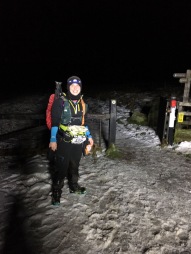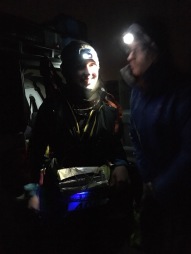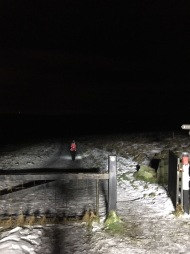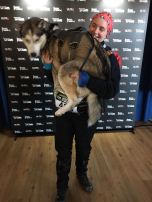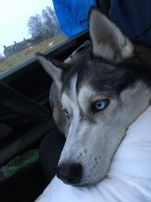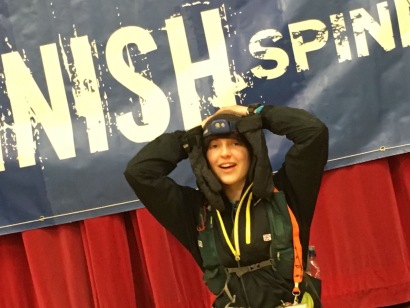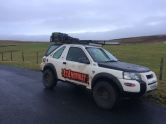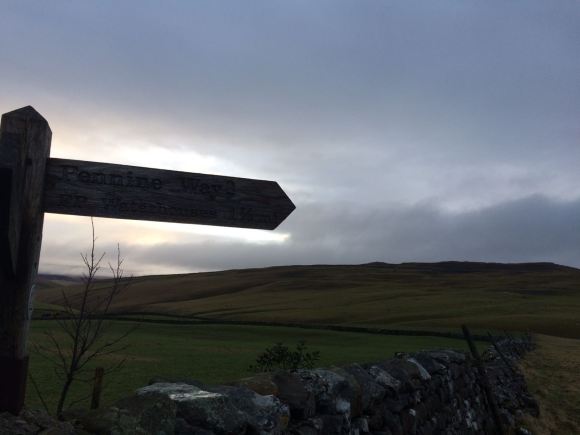Written by Ella Corrick - https://smallislandrunner.wordpress.com
Be warned: super long post!
At midday on Saturday January 14th I stood at the start for the Spine Mountain Rescue Challenge, UK winter ultra.
The race
The Spine Challenger is a 108-mile winter ultra following the southern half of the Pennine Way (PW) in north England. There is a time limit of 60 hours overall, which sounds pretty generous for a 100 miler, until you consider that the course record is around 30 hours and the DNF rate is extremely high. There is very little support along the course: only 1 formal checkpoint at mile 46 (CP 1 at Hebden Bridge) and a “mini checkpoint” where “hot water may be available” and “racers may be allowed indoors depending…”, no drop bags, at mile 82 (“CP 1.5” at Malham Tarn).
Racers must carry an extensive mandatory kit list, including stove, fuel, 3000kcal of food, medical kit, handheld GPS, full set of maps and compass, waterproofs and appropriate layering, sleeping bag rated to winter weather, and either a tent or bivy. There are only 7 hours of daylight this time of year here, and the weather is extremely changeable; previous races have faced diversions or forced suspensions of the race due to gale force winds, blizzards, and flooding. I was running in the Mountain Rescue Team (MRT) Challenge, a separate section of the race for mountain rescue team members, which set off 4 hours after the other Challengers, meaning more hours of darkness.
The start: Edale (Saturday midday. 0 miles down, 108.5 to go)
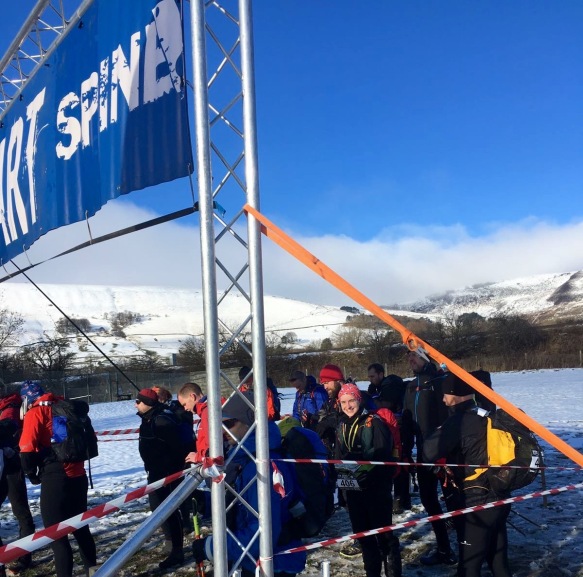
Lined up at the start
It was perfect weather for the start of the race. Blue sky, crisp, little wind, a few inches of crunchy snow on the ground. We started at midday from Edale village hall. I’d arrived an hour or so early to get my tracker fixed onto my pack (which would transmit throughout the race, mainly for safety but also for people to follow the race live online) and mill nervously around with the other runners.
There were only 20 of us in the MRT race, and only 2 other women. Since everyone was a Mountain Rescue team member, as expected everyone looked pretty hardy and prepared. The ladies in particular looked very confident and comfortable, and their packs looked a lot less held-together-by-carabiners than my higgledy-piggledy kit.
I’ve never started an event before where I felt so uncertain whether or not I was even capable of completing it. Probably the closest was when I ran Round the Rock, a summer 48 miler around the coastline of Jersey, when I had some doubts about my ability to beat the first cut-off. If I made that, though, I knew I could finish well within the course time. For the Spine Challenge, I wasn’t so much worried about cut-offs, I just didn’t know how far I could go. I did expect to be near cut-offs, so my half-baked plan was to try to go straight through the first night, carry on ‘til dusk on Sunday and see where I was to decide how long I could sleep. No more detail than that, and even that didn’t happen in the end.
I had an amazing support crew ready to meet me whenever the PW crossed a road. In fact, I had 2 teams. My day team was my parents and brother, and my night team was my partner and a friend, Tom and Methini. The night team were in our Land Rover with a little half mattress in the back, so I could curl up for a sleep if the chance arose.
Despite lots of insistence from everyone on the start line that none of us intended to run, this was a long hike, we all inevitably set off at a run across the muddy field and up the road towards the start of the PW. I slowed to a quick walk halfway up the road, knowing we had a few miles of gentle ups and downs before hitting the first big hill of the race. Our numbers were so few we were spread out almost immediately, and other than a brief chat to one guy, Anthony, about our yo-yoing (running downs and walking ups) strategy, I was pretty much on my own from here on in.
It didn’t take long to get to the hill. It starts as a long zig-zag of steps called Jacob’s Ladder up towards Kinder Scout. I’d been up here before for a picnic with Tom and Methini and it had been lovely. A bit of a leg-burner to get up all those steps, but really not so bad. Unfortunately, I hadn’t really paid attention that day, so I was quite unpleasantly surprised to realise, when I got to the top of Jacob’s Ladder on Saturday, that Jacob’s Ladder is only a small start to the hill. A beautiful curving ridge of snow showed me the climb that I still had left.
Eventually I reached the top and had a nice traverse through deep snow before heading out onto Bleaklow Moor. My legs were already aching and burning, and I reminded myself that this was the freshest my legs would ever be. It was not a comforting thought, but it didn’t scare me as much as it should have done.
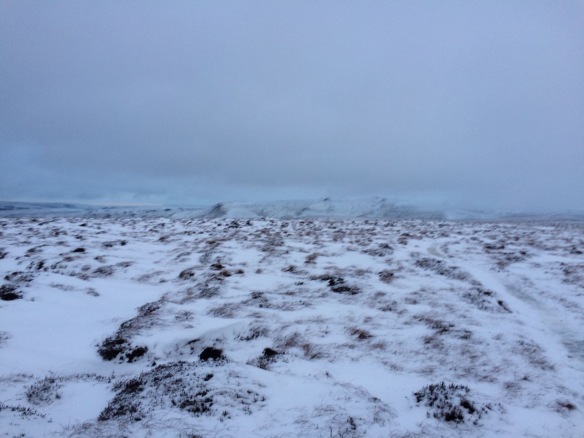
Bleaklow
Bleaklow is a pretty featureless place at the best of times. It’s a muddle of thick black peat littered with boulders ranging from fist to armchair size. In a way, the snow made things easier- usually, crossing the moor is to invite twisted ankles, scraped knees and hands, and possibly the occasional plunge into black peat up to the thigh. Following the trail blazed by the earlier Challengers, the snow nicely filled the gaps between the rocks and it was decently runnable in places.
The downside of this was that it was very tempting to ignore navigation and just follow the yellow brick road of footsteps. I was obsessively checking my GPS but even so was saved a detour by a walker up ahead waving at me as I followed the path towards him. I waved back and he gestured to me to go east. I looked east and couldn’t see anything- no footprints, no path. I started towards him and he shook his head lots, gesturing east. I waded knee-deep through snow a few paces east and discovered a tiny trodden trail in the snow. I checked my bearing and he was right- this was the PW, not the lovely path I’d been about to follow. I wonder how many people missed that turn.
Further up, the trail I was following began to feel wrong to me. I’d recce’d this bit and knew I should reach a cairn and then take a leftward track, and I just felt like the trail was off. I checked my bearing again and we’d already strayed off the PW, too far east. The cairn was almost directly north of me. I hesitated, GPS in hand, looking at the nicely trodden down path in the snow- in the wrong direction- and the deep snow and gorse. I’m sure the trail eventually curved back around to the PW, because other runners must have realised their error. Unless, of course, the trail wasn’t made by runners but by normal people out for a walk. I took the plunge and waded out into the snow, quickly working up a sweat cutting a new trail, and came in sight of the cairn in just a couple of minutes. I had a quick scout around and couldn’t see any decent track leading in towards it from the right direction, only two other lines of deep footprints where other runners must have down the same as me.
The rest of the track to the first road crossing was very straightforward. Some of it was flagstones, which were nice and runnable, but by now I hadn’t had another runner in sight for hours. Occasionally, one guy would startle me by running up from behind, then slow and walk with me for a minute chatting. He was running as a team with a friend, who he said already had blisters and was struggling, so he would run and catch up with me, then stop and wait for his friend, rinse and repeat. It must have been agony for the friend to catch up to him, nice and rested, and have to just keep on, and I wondered that he wasn’t getting cold during those stops waiting. I found out after the race that he retired at CP1.
I felt quite slow along here and was beginning to worry about my pace, so I was pleased when I began to catch up on 2 guys ahead. It was a bit gutting to get to them and find out they weren’t racers- they were Mountain Rescue team members out to support one of their fellow team mates, who had now gone past them. On the bright side, I was now in view of the first road crossing, Snake Pass.
Snake Pass (Saturday, 3pm. 10 miles down, 98.5 to go)
I saw the night support crew’s car at the crossing and was delighted, though surprised since support crews aren’t supposed to meet us at Snake Pass as it can be a bit busy. As it turned out, they were just getting out for a dog walk back south the way I’d come (though hoping to see me in passing) and they missed me. There was a Mountain Rescue vehicle to check us through this crossing and I accepted a coffee more out of gratitude that they were standing out in the cold to offer us help than actually wanting one. I’ve actually never had any kind of caffeinated drinks during races so I’m lucky my stomach puts up with most of my stupidity. Or at least, it did at this stage. More on that later.
The rest of this section was quite fun. The snow was absolutely beautiful across the moors and once I reached Bleaklow Head, there were some nice runnable sections. I was absolutely loving my shoes by now. I’d gone with Inov8 Oroc 280 having read a blog of someone who’d done the race in them and raved about them, and now I’m going to do the same. They have huge aggressive lugs and then metal studs as well and they were amazing. I was running over icy rocks and through thick mud confidently, and I think they must have saved me a huge amount of energy over the course as I didn’t fall once and I was saved an awful lot of ice-skating that I saw other competitors having to put up with.
As it got dark, I descended towards Torside Reservoir, where again there was an MR vehicle to check us through and offer us water. This time, knowing my crew were ahead, I carried straight on fishing out my headtorch as I went over the reservoir and up past Crowden.
Crowden (Saturday 5pm. 16 miles down, 92.5 to go)
Happily, I was greeted by my entire support crew (including 2 dogs) along the track near Crowden. I had a very quick chat, hugs from everyone, a cup of soup, and walked away eating half a cheese and ham sandwich. Already, Cliff bars and sweet things were beginning to pall; not a good sign 5 hours in!
The next section was nice and easy terrain for the most part. Lots of flagstones (covered in half frozen icy slush that my shoes treated like an easy pavement; I imagine people in less grippy shoes had a bit of trouble here). It was a lovely starry night and I was enjoying the easy terrain, but the darkness and blandness of the surroundings made it pretty boring.
Wessenden Reservoir (Saturday, 8pm. 25.6 miles down, 82.9 to go)
Both crews met me again. I was still feeling OK here. I grabbed a packet of Doritos and ate those as I walked off- these were my favourite race food throughout! By this stage, I’d stopped eating my Cliff bars. My nutrition plan had been 1/3rd of a bar every 30 minutes, meaning 270kcal every 1.5 hrs, or equivalent in calories from other food from my support crew. It’s a bit less than they suggest you have during a marathon, but I’ve never managed to keep up with the recommendation, plus the pace here is so slow that it’s majority fat-burning. If I’d been able to stick with it, I think it would have done me very well, but from this point on, eating became harder and harder.
This bit comprised long flat, if rather boring, tracks alongside a series of reservoirs. I wasted a bit of time faffing with my hiking poles (which I usually hate and only brought because so many experienced racers describe them as essential) getting them out for a hill and putting them away again.
I passed through Harrop Dale (Saturday, 9:40pm. 29 miles down, 79.5 to go) and crossed the M62 (Saturday, 11:30pm. 33 miles down, 75.5 to go).
Over the hours of darkness, alone, I was getting slower and more and more unhappy, making me slower still. I think it was a simple combination of the misery of constant darkness (around 6 hours of walking on my own in the dark by now) and inadequate calories, plus I was starting to get sleepy. I was beginning to get a bit desperate, and when I met my crew at Blackstone Edge (Saturday ~midnight. 34 miles down, 74.5 to go) I felt empty. I told them I needed a 10 minute sit down, mainly to spend that time basking in light, conversation and company. I sat on the back of the Land Rover with my feet dangling and they tried to make me eat, with limited success. I think I took a packet of hula hoops. The problem was, I knew from here it was a long stretch without seeing anyone- about 10 miles to CP1, which at my current pace was 4 hours. I was dreading it. Luckily, my support crew were exactly what I needed, ushering me away before I sat down for too long and being fairly unsympathetic. I headed back out.
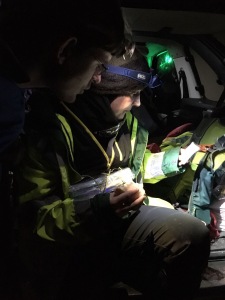
It’s HOW far to my sleep stop?
It was a bit of a grim haul. Somewhere, I caught up to a guy I ended up following for some time, probably annoying no end by letting his naturally quicker walking pace take him away from me, then I would jog until I was close again, then walk ‘til he started to escape again. It seems stupid in the real world, but in that mindset, I was letting him do the work of applying motivation to keep to a decent pace, and all I had to do was keep up with him one way or another. Eventually, I overtook him on a lovely downhill, only to realise (thanks to him calling and pointing it out) that we’d missed a turn. We schlepped back up and headed up towards the monument at Stoodley Pike, joined by three Irish guys who were doing the normal Challenger. They looked tired- they were 4 hours further into their race than us and must have been even more desperate for the CP than I was- and fell behind us.
After the beacon, I fell into walking with the guy I’d been trailing. He was lovely and it was unbelievably nice to have someone to talk to. Plus, he had done the Challenger before and was confident of the route into the checkpoint, and I let myself slightly relax my constant vigilance on route-finding as we made our way up. I’d recce’d this bit too and it was nice to be back in familiar territory, in company, and so very close to a place where I’d decided I was definitely stopping for a sleep.
CP 1 Hebden Hey (Sunday 4:45am, 46 miles down, 62.5 to go)
CP 1 is at a scout camp a mile or so off the PW. This in itself isn’t a problem, but the route down to it is a ridiculously steep, treacherous, narrow, unmarked slide of mud, tree roots and rocks that takes about 20 minutes to get down, much less the 30-40 to clamber back out. Before the race, several people warned me that plenty of people have ended their race on this path through injury, and to be completely honest, it pissed me off. I know the CP is part of race history and is never going to be changed, but the dangerous, miserable slither down just seemed like a needless dose of masochism. There are tough and dangerous parts elsewhere on the course, but that’s because they’re part of the PW. This bit is just a completely unnecessary pain in the arse. Of course, I might have had more of a sense of humour about it had I not been walking for 17 hours, awake for 21, and severely lacking in calories.
It killed me to walk past my support crew to get down to the CP, and killed me again to say no thanks to the invitation inside for a hot meal and climb back out, but finally I made it to the car where I could have a rest.
I had previously promised myself I would do no resting during daylight hours whatsoever, but having got to the car at 5:30, with daylight starting some time between 7-8am, I just needed the rest and gave myself ‘til 8 to sleep. My right shin was hurting so sharply I was slightly worried it might be a stress fracture. I wrestled my wet shoes and socks off, inspected the damage so far (the very beginnings of immersion injury, AKA trenchfoot, and several massive blisters on my toes), and ate what I could (about 2 mouthfuls of couscous and a couple of mouthfuls of a high calorie chocolate shake thing), then curled up next to my dog and went to sleep. My legs hurt a lot and I wasn’t convinced I slept at all, but Tom assures me I was snoring away, so I must have done.
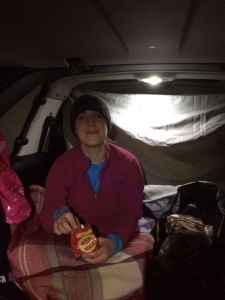
Somehow, I woke up feeling renewed. Even my right leg had quieted to a dull throb. I had a cup of that chocolate shake mixed with coffee, a pack of hula hoops, and a couple of bites of a sandwich while Tom heroically dealt with my feet (draining blisters and taping them up), then I headed out. My goal for the daylight hours was to get to Gargrave, at 70 miles, for a second sleep before a last effort to the finish.
The weather had warmed up to rain by the time I left CP1, so most of the ground from here on in was flooded. After briefly trying to skirt around the water (meaning huge detours off the path), I gave up and splashed through it all, sometimes nearly up to my knees. It was more like running in a streambed than on a path, but it was still quicker than the cautious approach and I overtook a normal Challenger on the moor. He seemed slightly disorientated and asked where the next turn was- it wasn’t for another couple of miles, as I pointed out on both GPS and map, but he didn’t believe me (or perhaps didn’t believe how slow the going was at this point, convinced he had gone further than I was showing him) and continued to stand staring at his map as I headed away.
I was in good spirits when I met my crew at the next crossing and didn’t hang about too much. I remember passing a man who was clearly really struggling. As I approached from afar, I thought I saw a hunched old man, so was surprised to see a young man’s face when he turned back to me as he was making his painful, slow way down the hill. I asked how he was doing and his reply wasn’t reassuring. He looked wan. I asked when he last ate; he said not for a three or four hours and I told him he needed to eat, offering him what I had. He said he would be fine and was meeting his crew down at the reservoir, so after double-checking he was OK I pushed on.
At some point, my left knee had started to produce a stabbing pain whenever it moved- it made me make strange noises as I went downhill- but overall in myself I was feeling steady for now, in a fragile way that I knew wouldn’t last. There were several massive downhills to go, especially Fountains Fell and Pen Y Ghent, and I wondered if I could do them at a fast enough walk to be within the cut-off.
I managed to miss my day crew at the next stopping point at Ponden reservoir, but they found me at a back-up crossing not much further. My wonderful mum had brought pizza, the first food that sounded attractive to me in a long time, and I ate three slices. At a later crossing, she produced Battenberg cake and more pizza, as well as three varieties of sandwich and sausage rolls. I really couldn’t have done it without my crew!
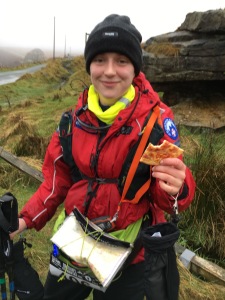
It all went (figuratively) downhill from there. It was an endless series of fields, which sounds like it should be easier going than moors and fells, but it felt far worse. The mud was always ankle-deep at best, meaning each step was actually a lunge, leaning onto the slippery footing of the leading leg to pull the back foot out of the sucking, sticking mud, over and over again.
Fog settled in around me. It soon got dark and my mood plummeted. There was nothing to see but a few feet of mud ahead of me and nothing to do but examine my bearing or follow the most obvious trampled line of mud and hope I hit the next boundary at the right spot for the stile. It was unbelievably tedious and got to the point where even a wall looming slowly into view was a nice bit of entertainment. “Oh, I was imagining a fence for this field for some reason. That’s a nice wall.” And inevitably, “Oh bugger, that’s a high stile.” By now, to get my foot high enough to get onto a stile required a little swing of my leg, sometimes needing a second attempt, then a laborious clamber with my arms doing at least half the work. Kissing gates are the best invention in the world and I’d be quite happy if every stile in the country was replaced by them.
I took a wrong turning into one field and by this point was so exhausted I wasn’t thinking straight. Instead of going back to the track and along to find the right way in, I thought I’d just go over the barbed wire fence. It looked from the map as if that’s where the path lay. With lots of faff, I narrowly made it over the fence without injury, though tore my gaiters badly, to find myself in a horribly sloping bit of wasteland full of overgrown trailing plants, fallen logs, and certainly no path. I crossed it to another barbed wire fence and went over that, into a field with a huge shining body of water across the middle of it. Still no PW. Finally, I got hold of my senses and took a bearing back to the track I had been on, tramped up to it, over a gate and found myself about three feet further along than where I had left it, now even more exhausted and furious with myself. A few feet further on, there was a kissing gate into a field with a path of mud leading clearly away into it.
After a hundred years or so of random diagonal paths across fields, I finally reached the haven of Gargrave. I was as desperate for social interaction as I was for sleep, so chatted with my crew as I changed into dry things and ate three bites of pasta. I lay down with my feet up on my pack and tried to sleep, now an even harder prospect than it had been at Hebden with my knee and shins throbbing.
Gargrave (Sunday 10pm. 72.5 miles down, 36 to go)
Unlike my previous sleep, which left me feeling refreshed and rested, I woke from my rest at Gargrave feeling like death warmed up. It didn’t help that it was 2am and I knew I had to set off into the now hated dark again. It also didn’t help that as soon as I tried to eat, I started throwing up. Not a good sign. I wasn’t sure if this was a symptom of my failure to get enough calories in, irritation of my stomach because I’d been taking ibuprofen regularly for the last 24 hours (although I’d been staying carefully within safe limits, ibuprofen is never a good idea during endurance exercise), or just sheer exhaustion. I sipped water and ate a few Twiglets, and let Tom and Methini bully me into eating half a sandwich. I couldn’t finish it even with their insistence.
Also, due to mistakenly chucking my socks into a bag of rubbish, I had now run out of waterproof socks. In fact, I’d run out of socks entirely. I ended up borrowing a pair of Tom’s (he’s only about 5 shoe sizes bigger than me) and duct-taping plastic bags over the top of them. We hoped the day crew could recover the waterproof socks from the rubbish, quickly dry them, and meet me later on to change again.
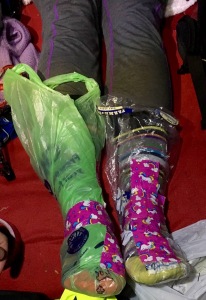
The only factor in my favour was that I had recce’d Gargrave to Horton-in-Ribblesdale, the next 22 miles of the route, and it felt familiar and welcoming. I was dreading Fountains Fell (a long, long climb) and sad that I wouldn’t be able to enjoy running down the other side as I had during my recce, but for the first time, I started believing maybe I could actually finish. It was enough to get me back on my feet and out.
Malham (Monday 6:45am, 78.8 miles down, 29.7 to go)
It felt good being on familiar territory, but the way to Malham was spoilt by my newly traumatised relationship with fields. What had been a lovely sunny stroll through pretty fields alongside rivers during my recce was now a miserable slog through at best mud and, more often, shin-deep water.
On the bright side, every new change over of water in my shoes and socks was quite soothing to my aching feet. I had been hoping to meet my night crew at a road crossing halfway, but it was the tiniest unmarked road crossing and they were both as sleep-deprived as me, trying to navigate unfamiliar territory at night in the fog, so unsurprisingly, they weren’t there at the precise moment I crossed. It shows how fragile my morale was that this left me crying for the next couple of fields, even though I didn’t need anything from them and hadn’t planned to stop.
I wasn’t as happy to reach Malham as I should have been. It’s a lovely little village and I had been expecting to feel overjoyed when I got here. Instead, I was dejected and poor Tom and Methini had to balance sympathy with practicality, only letting me sit down for long enough to decide what I wanted to eat as I walked away. Obviously, the answer was nothing, but I grudgingly took a handful of Twiglets to munch as I walked away.
The pre-dawn light showed me Malham Cove as I approached and I began to cheer up. There were two mysterious lights wandering around at the top and I sped up slightly, a little worried- had a runner dropped some vital piece of gear? Were they completely delirious? As I climbed the steps up the cove, I met the two coming down. It was two of the Irishmen I’d met near Stoodley Pike. I’d actually overheard them coming into Gargrave and debating what to do- being in the normal Challenger, they were 4 hours ahead of me, so 4 hours closer to their cut-off. It was about 7:15am on Monday now, and they had to be at CP 1.5 the other side of Malham Tarn by 8am. Evidently, they had decided to carry on through Gargrave without rest, which is more than I could have done by that stage.
They told me they’d been poking about in the rocks up at the top of the Cove for hours trying to find the PW, but they were so tired it was getting dangerous and they’d decided to retire. I felt terribly for them- they had pushed so hard to make it here, and were going to be timed out for this. I knew exactly why they’d had so much trouble—the top of the Cove is an enormous limestone pavement and the PW sneaks through then behind it, to scuttle through a valley. On my recce, I’d missed it and followed a different footpath completely, despite daylight, plenty of sleep and a GPS. I told them I was fairly confident I could navigate us to it and was happy if they wanted to come with me and they hesitated in their descent, then shook their heads. They would never make it to CP 1.5 in time anyway. I left them making their painful way down the steps and hurried on, the closeness of my own cut-off now stark in my mind.
Finding the PW, even knowing my previous error, taking very careful bearings and the benefit of dawn, was very difficult. It was made worse by my increasing lack of balance on my painful legs, so that I didn’t dare do any clambering over the boulders or go anywhere near the crag edge. I ended up doing a cautious skirt inwards from the crag, aiming for a point where I knew I’d meet the PW the other side of it. It was slow but it worked and I set off for the Tarn.
I met Tom and Methini in the car park before the Tarn in much better spirits than I’d been back in Malham. Daylight was everything to me now and lifted me enormously. I was worrying excessively about the cut-off, though, constantly trying to do mental arithmetic to calculate what time I might get where, and if I had time to finish. CP 1.5 was 82 miles in, so I’d still have almost 30 miles still to go. The distances were so big my mind was sort of numb to them. I didn’t try to contemplate what 30 miles feels like or whether I was even capable of 30 more miles, I just considered how long it would take. I was down to about 2mph, so 15 more hours. Say I get to CP 1.5 at 9, 15 hours is, oh shit, it’s midnight. That’s the cut-off.
I set off at a determined march. Well, a hobble, but a determined hobble. I’d been using my poles heavily for the last 24 hours, more to take some of the weight of my legs than to help propel me, and had been walking in a tentative way that minimised the pain. I decided I didn’t have time for this any more and flung the poles down as I reached my crew. Now I would just try to walk as fast as I possibly could and do my best to accept the pain. I knew limping would only bring new injuries and strains of its own, so I was trying to walk as normally as I could. It bloody hurt. I had a mantra, though: Malham Tarn, Fountains Fell, Pen Y Ghent, Horton, Hawes. That was all that was left. I just had to do it.
This march got me around the Tarn steadily and I made my way up to the checkpoint, but I was hurting and I was worried about the cut-off, and generally not doing well. As I came in, a member of staff came out to ask how I was doing. The kindness was too much and I told him I was on a knife’s edge, and burst into tears. The poor bloke probably had no idea what to do with me as I tried to ignore the fact that I was practically sobbing and scrabbled with my kit, asking if I could possibly have a refill of water. His response was perfect, though, as he efficiently topped up my bottle while I washed my face in a sink and tried to get control of myself. He checked if I wanted a brew or a sit down and I insisted I wanted to make a move on, explaining I was worried about the time. As I left, he nipped round the building the other way and was standing waiting as I passed, where he gave me a perfect pep talk. “I think you’re just having a discouraged spell. You’re walking really well, looking great, and you’re 3 hours ahead of time. Just keep going.”
Now the mantra was: Fountains Fell, Pen Y Ghent, Horton, Hawes.
I had a dread for Fountains Fell for the entire race. On my recce, it had wiped me out— it’s a long slog up and up and up—but I’d loved zooming down the fairly technical but great fun steep route on the other side. Strangely, it was exactly as bad as I’d expected but I quite enjoyed it, at least relative to other sections of the race. By now, uphill was far less painful than down, and thanks to the daylight I got to enjoy the rewards of my climb when I stopped to catch my breath now and then. It was a painstaking hobble down the other side, doing that one-two pattern that toddlers use down stairs, but I could see Pen Y Ghent in glimpses when the distant fog cleared and I felt in reach of the finish.
After Fountains Fell (Monday 12:25pm, 89 miles down, 19.5 to go)
I met my parents at the road and told them I was thinking of pressing on rather than stopping for a foot change. Luckily, they override my sleep-deprived stupidity and told me I had to get dry socks on. It was my longest stop besides my sleeps, and I was extremely grateful for the socialising. They told me news about other racers, including the fact that I was the only woman left in my race, and had been for some time. It didn’t change my determination to reach the finish, but it added a bright note that no matter how slow I felt, I was doing well to still be moving.
Pen Y Ghent, Horton, Hawes to go.
PYG (“pig”) as I called it in my mind wasn’t too much of a pig to get up, steep but straightforward. Thick fog surrounded me once more so there was no view to speak of. Again, my lack of balance slowed me down as there’s a section that’s a hands and feet scramble at the best of times. With 5 hours sleep in the last 50ish hours and a barely functional left knee, I took this at an extremely slow pace, placing each foot very carefully. The real pig of the thing was getting back down: a three mile rocky track downhill to Horton. It was grim and every time one or other of my feet snagged on a rock, I gave a little yelp as hot pain bloomed in my shins and left knee. My mum met me at the bottom (with one of the crew dogs) and I made my way to Pen Y Ghent café in Horton. Only Hawes to go!
Horton-in-Ribblesdale (Monday 3:30pm, 94 miles down, 14.5 miles to go)
I tried the cheese toastie my crew had kindly bought me—I managed one bite and nearly threw up. Nevermind, not far to go. I cheerfully told everyone that it was only 6 or 7 miles left, one last push! A silence that I didn’t notice greeted this and I hobbled into the public toilets (the only time I got to use proper toilets for the entire race; it was lovely).
My mum stuck her head into the loos as I was washing my hands.
“I hate to be the bearer of bad news,” she said.
Uh oh.
It turns out I had got confused in the last 25 miles and had convinced myself it was 6 miles from Horton to Hawes. It was more like 14. I stared blankly at her as she gently explained this. I honestly didn’t know if I could do this. 14 miles? That’s 7 hours. Almost a normal work day, but of nothing but hobbling along alone in the fog. And it would be dark soon.
“OK,” I said, and numbly I carried on.
As I climbed up onto the moors, I was a jangle of misery. It was as if all the threads of my personality and emotions had frayed into childish self-pity and there was a chorus of voices in my head saying nothing but, “I don’t want to. I don’t want to. I want to stop. I just want to stop. I don’t want to. Seven hours.” There was just one steel wire in the middle that had decided I was carrying on. It was a tyrant over the rest of me, so even though almost all of me wanted to just lie down and stop, I couldn’t because there was no decision to be made. I was carrying on, and that was that. It didn’t shut the rest of the voices up, but it kept my legs moving.
I was exhausted, though. Truly exhausted. I felt as if I had been hollowed out and was a shell of a person, fragile, barely even there. My legs had felt done when I got to CP 1 at Hebden, 50 miles ago. Under normal circumstances, had I stopped there, I would have taken a couple of days to recover enough to go for a walk. Instead, I’d kept going, and somehow, my body had let me. I was empty, every tiny step hurt inordinately, but in some ways my legs still felt strong. I told them to move and they moved. I felt utterly awful, but it was an incredible feeling too.
When darkness fell, my world was reduced to a few steps of white mud track ahead of me and droplets of moisture in the air. If I reached out in front of me, my fingertips were fuzzy in the fog. There was nothing to see, nothing to think about except the hours left to go. I started taking little breaks crouching down, my forehead resting on my knees with my eyes closed for a few breaths. They did nothing except slow me down and make my knees ache, but I kept doing it.
I was desperate for some distraction, anything, and suddenly thought to dig out my phone. I’d had it switched off the whole way, no time for photos or need to contact anyone. Switching it on, I was amazed to find I had signal. Messages poured in. My support crew had a Whatsapp group to let each other know how I was doing, where I was, and had invited friends and family to join the group so they could keep tabs on me. All of them were watching my online tracker too. There were over 80 messages.
For the next half hour, whenever the ground was smooth enough not to fall over, I read through every single one of those messages of support. I had felt like I was the only living thing on the planet, wrapped in my self-doubt, self-pity and discomfort walking up that dark, foggy hill, but here were other people watching my slow, slow progress towards Hawes. It helped me grit my teeth and resist the pauses. I had to keep moving—they were watching me move, they were willing me to Hawes. I would get there.
Even with this boost, I was struggling. I was literally delirious with tiredness and had been mildly hallucinating for the entire climb. Shapeless rocks always rise out of fog like people or animals and we’ve all had that funny momentary, “Oh! I thought that was a dog, but it’s a boulder!” These weren’t like that. I would see a dog, or a dinosaur, or once a porcupine that had been cut in half rising out of the fog and be confused. Then I would worry—it wasn’t right for that to be there. Why was it there? My heart rate would go up and I felt scared until I was right on it, sometimes even stopping to stand over it and stare, and realise it was just a rock or clump of reeds. Every night I had been glimpsing distant lights through the darkness and mistaken them for other racers, only to realise they were houses, cars, planes, all sorts. Now, those mistakes had a vaguely paranoid edge to them. I was sure I’d seen a light just there but now it was gone—someone must be hiding from me in the fog. I knew I was hallucinating, but it was still unnerving. It made me laugh as well, though. I always carry a little plastic dinosaur in my pack for luck (don’t ask), so perhaps that’s why dinosaurs featured quite prominently. I think part of it was that my tired mind was desperate for some sort of stimulation besides fog and darkness and the relentless pressure to keep moving, so started producing images just for something to do; at least they gave me some entertainment.
I’d been warned that Cam High Road is a hill that goes on forever, but I’d always taken the description to be figurative. Nothing can go on forever, after all. But it turns out, Cam High Road does. It goes on forever. It’s quite possible I’m actually still walking up that bloody awful hill and just hallucinating being at home on a computer, to be honest. I hate it, I will always hate it, and it is the worst place in Britain. Possibly the world.
Miraculously, my support crew managed to get up onto the Cam High Road somehow- it’s miles up a dirt track and must have been terrifying to get up in that fog. My mum suddenly appeared out of the aether ahead of me.
“How are you doing?” she asked. Until now, my answer had always been positive, or at least slanted that way. Mum thought this race was a stupid idea, that I would quite possibly die, and I shouldn’t do it. I was scared if I showed her how hard I was finding it, she would encourage me to drop out, and flimsy as my resolve was becoming, that I would agree. I didn’t have any positivity left.
“I need a hug,” I told her.
She wrapped her arms around me and for a moment I rested my forehead against her shoulder, trying not to cry. Then she let me go, turned around and started walking. I followed.
“You can’t stop now,” she told me. “What do you need? Water? Food?”
That was that, then. If Mum said I couldn’t stop, it must be serious. I managed to conjure a weak smile for my dad and brother as they emerged from the fog, declined any food or drink, and headed off, back into the lonely darkness.
After five or six lifetimes of continued hobble-marching, overtaken by multiple people doing the full Spine (whom I had an 18 hour head-start on, and all of whom were mind-bogglingly cheerful and sprightly), I realised I had taken the wrong track and there was a head torch on the correct path above me. Considering that I was struggling to put one foot in front of the other on a dirt track, I was surprised to find myself able to clamber up the steep ascent through thick heather. I emerged onto the path to meet Anthony, the Mountain Rescue racer I’d spoken to briefly right at the very start, before Kinder.
He wasn’t much appreciating the fun that Cam High Road had to offer either. To paraphrase just very slightly, his opinion of it was, “Blimey, this darn hill is a jolly old foozler, wouldn’t you say?”
I agreed, in similarly colourful terms, and I can’t explain what a joy it was to share my hatred of the hill with someone. He was struggling with his breathing (a winter ultra isn’t the best time to discover you’ve cold-induced asthma) and I was struggling with my knee, and we probably slowed each other down if anything, needing stops and pauses for different bits of the terrain. I didn’t care—the company was brilliant. We swore our way down the hill and the first lights of Hawes came into sight.
Anthony was keen to push on, but kindly agreed to stick with me—I tried to match his run once we hit the road and instantly sick pain shot up both my lower legs. We marched as best we could, me with elbows swinging wildly as if my arms could make up for my legs’ lack of power, and him wheezing and puffing, through the dark, quiet streets.
A marshal in fluorescent yellow appeared out of nowhere at the same time as my dad called out to me, and the two of them escorted us the last few hundred metres to the finish, where a Montane flag stood outside Hawes village hall and staff and family waited, clapping us in to the finish.

I did it. First (and only) women’s finisher of the Spine Mountain Rescue Challenge 2017.
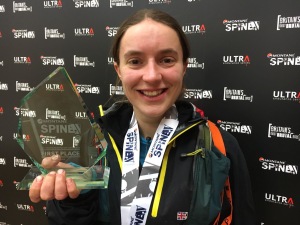
Hawes (Monday, 9:58pm. 108.5 miles down, 0 to go)
Overall, of 20 MRT starters, 1/3 women finished and 11/17 men,making it a 40% DNF rate this year. The main challenger had 94 starters and a 43% DNF rate. It was so much harder than I imagined and an amazing experience; I think its effects on me (physically and mentally) are going to take a while yet to fully sink in.
Thanks so much to the organisers and my awesome support crew. Shorter follow-up post to come with a review of my kit.

